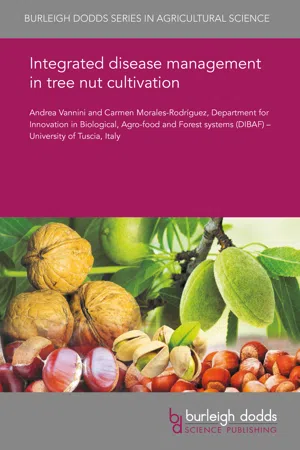
Integrated disease management in tree nut cultivation
- English
- PDF
- Available on iOS & Android
Integrated disease management in tree nut cultivation
About this book
Integrated disease management and use of protocols and products that minimize the environmental impact are paramount needs in the cultivation of tree nuts. In this chapter, such approaches are proposed for chestnut cultivation and, specifically, for the management and mitigation of damage caused by one of the most threatening diseases affecting chestnuts worldwide – ink disease caused by Phytophthora spp. The chapter starts by introducing the concept of area-wide integrated ink disease management, followed by sections on monitoring and GIS mapping of the disease, and landscape features of the disease – Phytophthora being easily dispersed via water and infected soil. Also covered are tree and soil treatments used to treat the disease, and a review of the varieties resistant to the disease (breeding of interspecific hybrids has led to resistant rootstocks). The chapter concludes with a discussion on the importance of quality and certification of material for propagation.
Frequently asked questions
- Essential is ideal for learners and professionals who enjoy exploring a wide range of subjects. Access the Essential Library with 800,000+ trusted titles and best-sellers across business, personal growth, and the humanities. Includes unlimited reading time and Standard Read Aloud voice.
- Complete: Perfect for advanced learners and researchers needing full, unrestricted access. Unlock 1.4M+ books across hundreds of subjects, including academic and specialized titles. The Complete Plan also includes advanced features like Premium Read Aloud and Research Assistant.
Please note we cannot support devices running on iOS 13 and Android 7 or earlier. Learn more about using the app.
Information
Table of contents
- 1 Introduction
- 2 Area-wide integrated management of ink disease
- 3 Monitoring and GIS mapping
- 4 Landscape features
- 5 Tree and soil treatments
- 6 Resistant varieties
- 7 Quality and certification of propagation material
- 8 Conclusions
- 9 Where to look for further information
- 10 References